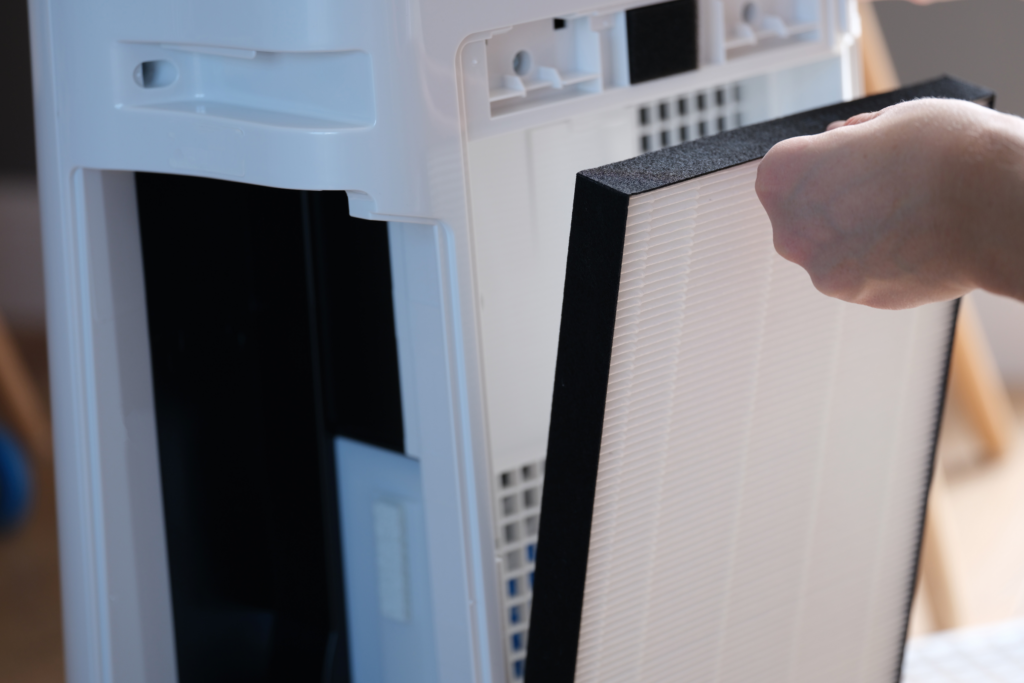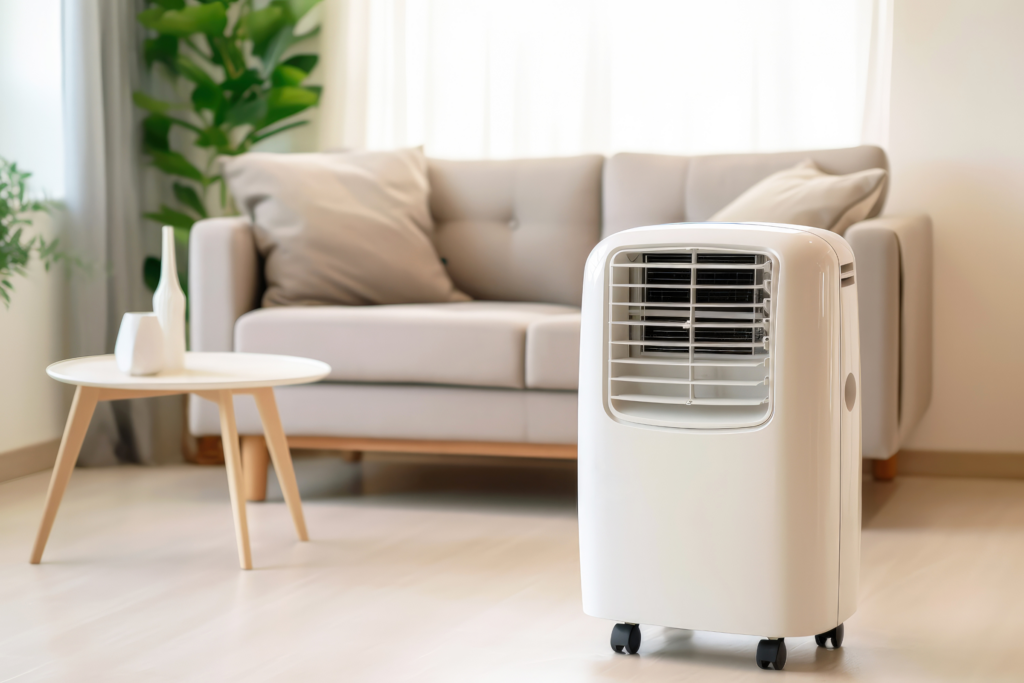Why is My Portable AC Producing So Much Water – Top 5 Reasons
It’s natural for a portable air conditioner to emit water during the cooling process. This is because portable air conditioners use a refrigeration cycle similar to compressor-based air conditioners.
Portable ACs will produce excessive water because of high humidity, a dirty filter, it is a new AC, a faulty condensate pump, or a drain hose problem.
Continue reading to learn why your portable air conditioner produces so much water. We’ll also show you how to avoid having to go through this again and again.
Why is my portable AC producing so much water?
While there are many potential issues that could cause excess water with a portable AC unit, these are the most likely:
| Problem | Description | Suggested Solution |
|---|---|---|
| High Humidity Area | High humidity can cause your portable AC to condense more water, filling the pan quickly. | 1. Buy a fully evaporative portable AC. 2. Use a dehumidifier. |
| Dirty Air Filter | A dirty air filter restricts airflow, causing the evaporator coil to freeze and produce more condensed water. | Clean the air filter with lukewarm water and allow it to dry before re-inserting. |
| First-time Use of New AC | A new AC may produce more water initially, especially if there was no previous dehumidifying system in the room. | No immediate solution; water production should normalize as room humidity decreases. |
| Problem in the Condensate Pump | A faulty condensate pump or a blocked drain hose can prevent water from being removed, causing accumulation. | Check the pump and the drain hose for issues. Repair or replace if necessary. |
| Water Tank or Drain Hose Blockage | Sometimes the water tank or drain hose can get blocked, preventing the water from draining out. | 1. For a blocked tank, remove the drain valve and try to drain it. 2. Check and clear any obstruction in the drain hose. |
1. Are You in A High Humidity Area?
A portable AC produces water when it condenses the moisture in the atmosphere. This means the amount of water your portable AC has depends on the humidity in the air. So, if you are in an area with high humidity, expect more water from your portable AC.
As a result, it will fill the water pan within no time, requiring you to frequently empty it. To avoid experiencing such problems, you should consider buying a fully evaporative portable AC.
Alternatively, you can invest in a good dehumidifier to help remove excess moisture in the atmosphere. The dehumidifier will help reduce the workload of your portable AC, especially during the extremely high humidity season.
2. Your Portable AC’s Air Filter Is Dirty
If your portable AC is producing too much water, it could be you have a dirty air filter. The cooled air from the portable AC passes through an air filter before getting released into the atmosphere. The air filters help remove dirt, dust, or debris in the air.
This means the dirt or dust accumulates on the filter over time. So, it would be best if you cleaned it regularly. If you don’t clean your air filter, it will prevent air from getting out of your portable AC. Also, the air supply to the evaporator coil will be reduced.
Instead of the evaporator coil releasing cooled air, it will retain it. This can make the evaporator coil freeze and increase the amount of condensed moisture. This then comes out to the condensate pan. You will have to keep emptying the pan since the cooling process is continuous.
To avoid experiencing this problem, you should clean the air filter. Remember, your portable AC will not turn on unless you clean the filter. You can remove and clean the filter using lukewarm water, then give it time to dry before returning it. Air conditioners have reusable filters, so you won’t have to buy another one when the other is dirty.
After that, you can check if your portable AC has the filter reset indicator and ensure it’s on. It should turn on automatically when the filter is dirty or some hours during the cooling process.

3. Is It the First Time You’re Using a New Portable AC?
If you bring a new portable AC home, expect it to produce more water. This is not a problem with the AC. The reason is that the new portable AC will draw a lot of moisture if you did not previously have any other AC or dehumidifier.
You cannot solve this condition. But when the humidity level in the room goes down after dehumidification, your AC will work normally. It won’t produce excess water as before.
But if the condition is persistent, it means your portable AC is not the right choice for your location, or it’s faulty. In this case, you can consider getting a replacement from your supplier or buying one suitable for your area.
4. Underlying Problem in The Condensate Pump
Some people prefer installing condensate pumps on their AC to avoid regular emptying of the water pan. The condensate pump directs the water to your preferred location, such as out a window, and is easy to fix.
However, if your portable AC still produces a lot of water after installing the pump, it means there’s a problem with the condensate pump setup. It could be that the condensate pump is faulty or its drain hose is bent or blocked.
This makes it hard for the water to find its way out of the system. You can check if the pipe is functional before and after using your portable AC.
5. Water Tank or Drain Hose Blockage
If you have certain portable AC models, you must manually remove the water from the tank. However, sometimes, the tank may not allow you to drain the water, even if its indicator shows the water tank is full.
It’s because of a clogged water tank, which then fills with water without emptying. You can identify this by removing the drain valve and trying to drain the water. If little water comes out, but the tank is full, it’s either faulty or blocked.
If your portable AC is filling up quickly, another cause could be a faulty or blocked drain hose. In this case, the drain hose isn’t letting out the water as it should be.
The main cause can be a bend in the drain hose that aids in dirt accumulation, preventing water from draining with the help of gravity.
What can you do to make your portable AC work normally?
If you want to stop your portable AC from producing excess water, it’s best first to identify the root cause. After that, you can know how to handle the situation since each problem has its unique solution. Most of these problems are things you can fix without calling a technician.
- Clean the drain hose
- Clean the water tank
- Check the air filter
- Empty water tank
However, regular maintenance is always helpful. Ensure you clean the drain hose and water tank, check if your air filter is clean, and regularly drain the water pan. But if your portable AC has no drain hose or condensate pipe, consider installing them to help exhaust the humidity, especially in highly humid areas.

Can you run a portable AC constantly?
It is completely safe to run a portable air conditioner 24/7. That said, there are a few things you should keep in mind.
- Constant running will shorten the lifespan
- Increases electric bill
- The water tank requires frequent emptying
Everything has a limited lifespan. The longer you run your portable AC, the quicker you will wear it down. Eventually, you will need to replace the unit.
On top of this, having your AC running constantly will only increase your electric bill. You will be nice and cool, but your wallet might suffer.
Lastly, you will need to empty the water tank continuously. How often you do so will depend, but it will quickly become part of your daily routine.
How Often Should You Drain the Water Pan of Your Portable AC?
Even though you should regularly drain your portable AC, the frequency varies depending on a few factors. For example, if you live in a place with high humidity, you should not wait until the water spills all over the house. Do this regularly every day.
The frequency also depends on the model of portable AC you’ve got. A portable AC with self-evaporative technology humidity will automatically come out through the vent. But if your portable AC is only partially evaporative, you will have to monitor the water tank and drain off the water regularly.
If you use your portable AC for longer hours, you’ll need to empty it more often.
Frequently Asked Questions (FAQ)
How do I stop condensation in my portable air conditioner?
In most cases, you can’t. Or rather, you can’t with standard portable air conditioning. To stop condensation from being a problem, you’ll need a fully evaporative AC.
Which portable AC should I buy to avoid experiencing water overflow?
There are two classifications of portable AC. The partially evaporative AC and fully evaporative AC. Most brands of portable ACs are partially evaporative ACs. They require you to drain the water often as they’ll not exhaust all the moisture.
We recommend fully evaporative portable AC, which removes all humidity from the atmosphere and exhausts the most.
Should I call a technician when my portable AC produces a lot of water?
No. You don’t have to call a technician when experiencing such problems since they’re easy to fix. All you need to do is identify the underlying cause and act accordingly.
Why should I be careful with the features of the portable AC?
Understanding the features of the portable AC prevents you from having an ineffective machine. So, if you want to humidify your place using a portable AC while not producing much water, get the type that will do it best.
Summary of why is my portable ac producing so much water
There are several reasons why your portable AC might be producing excessive water. It could be high humidity, a dirty filter, or a condensate pump and water tank problem. To solve the problem, identify the main cause before looking for the right solution.
But why is my portable AC producing so much water, and it doesn’t have any of these problems? It could also be the type of portable AC you’ve got that doesn’t exhaust moisture or the area you live in is too humid.
Let Us Know How We’re Doing!
Did this expertly prepared resource answer your question?
Do you have another question about home maintenance, home improvement projects, home appliance repair, or something else?
Get more information, send in questions and keep the discussion going by contacting the I’ll Just Fix It Myself company customer service team at at 1-800-928-1490 or Email us at [email protected]
